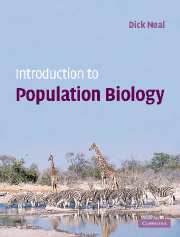Book contents
- Frontmatter
- Contents
- Preface
- Acknowledgements
- PART I Evolution by natural selection
- PART II Simple population growth models and their simulation
- PART III Population genetics and evolution
- PART IV Demography
- PART V Interactions between species, and the behaviour of individuals
- Glossary
- Solutions to problems
- References
- Index
Solutions to problems
- Frontmatter
- Contents
- Preface
- Acknowledgements
- PART I Evolution by natural selection
- PART II Simple population growth models and their simulation
- PART III Population genetics and evolution
- PART IV Demography
- PART V Interactions between species, and the behaviour of individuals
- Glossary
- Solutions to problems
- References
- Index
Summary
CHAPTER 4
The λ per year = 6000∕5000 = 1.2, and so the rm per year = ln (1.2) = 0.18232 (using Eqn 4.6). The population size after three years can be estimated using either Eqn 4.2 (Nt = 5000 × 1.23 = 8640) or Eqn 4.2 (Nt = 5000 × e0.18232 × 3 = 8639.96, or 8640).
The λ per century = 900 million∕600 million = 1.5, and so the rm per century = ln(1.5) = 0.4055 (using Eqn 4.6). The rm per year = 0.4055∕100 = 0.00405. The λ per year can be calculated, using Eqn 4.5, as e0.00405 = 1.004, or approximately 0.4% per year.
A 15% increase per year = λ of 1.15 per year. When the population doubles in size, Nt∕N0 = 2. If we rearrange Eqn 4.2, we can see that 2 = λt. Taking the logarithm of both sides (i.e. ln(2) = ln(λ)t) we find 0.6931 = 0.14t, and so t = 4.96, or approximately 5 years.
First convert the rm per week to rm per day so that rm and t are in the same time units. So, rm of 0.14 per week is equivalent to rm = 0.14∕7 = 0.02 per day. Then use Eqn 4.4 to estimate Nt, setting N0 to 24, rm to 0.02, and t to 65. The answer is approximately 88 rats.
The multiplication rate (λ) over a four-week period is 5. Using Eqn 4.5 we calculate the rm per four weeks as ln(5) = 1.6094. The rm per day is 1.6094∕28 = 0.0575, and we may use Eqn 4.5 to calculate the λ per day (λ = e0.0575 = 1.059).
[…]
- Type
- Chapter
- Information
- Introduction to Population Biology , pp. 367 - 377Publisher: Cambridge University PressPrint publication year: 2003



